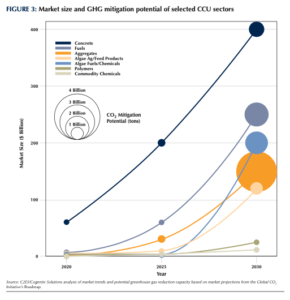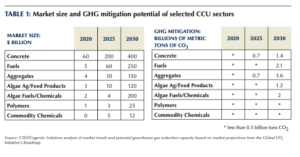A $320 billion market that could also capture 3 billion tons of carbon emissions
A recent report by the Center for Climate and Energy Solutions (C2ES) takes a close look at using carbon emissions as a feedstock to more efficiently decarbonize economies around the world. The authors identify an enormous opportunity for algae.
C2ES published “Carbon Utilization–A Vital and Effective Pathway for Decarbonization” to examine how carbon utilization processes not associated with enhanced oil production (EOR) might lead to emissions reductions. In other words, how CO2 can be captured and used to manufacture things like construction materials, fuels, plastics, chemicals and more.
ABO worked closely with C2ES on the report, and the chapter on algae identifies some near-term opportunities as well as larger applications that will unfold over time.
A Big Market, and Big Carbon Reductions
C2ES estimates that by 2025 the market for algae-based products will be approximately $14 billions, but then expand dramatically to $320 billion by 2030.


The market size is impressive, but so is the amount of CO2 that could be used. The report indicates that by 2030 the CO2 use potential of algae-based products could approach 3 billion tons.
The report also highlights the fact that algae production does not require purified streams of CO2 in order to be productive. In many cases, flue gas from a power plant can be fed directly to microalgae, reducing the need for expensive purification equipment. In fact, some combustion waste products like nitrogen oxides or sulphur oxides can be used as nutrients by algae.
Furthermore, the CO2 used to grow algae doesn’t have to come from fossil sources. Direct air capture or other industrial processes are also being examined as feedstock sources. This opens the door for algae to play a role in reversing runaway climate change.
Combining a Strong Market Pull With a Smart Policy Push
The authors note one of the most remarkable advantages of algae in carbon utilization is the wide range of products that can be made. They list just a sliver of what’s possible: livestock and aquaculture feed, omega-3 fatty acids, beta-carotene, food products, bioplastics, biopesticides, biostimulants, biofertilizers, bio-methane for electricity production, bio-jet fuel, bio-ethanol, and bio-diesel.
Since some of these products already have demonstrated market commercial value, market economics could lead to industry scale-up.
There is broad potential to offset the capital costs associated with algae production facilities near industrial CO2 sources, like power plants. This is a vital distinction, since real emissions reductions will require a significant market pull that arises from a demand for low-carbon products, in addition to new policy support.
To give carbon utilization the policy push it needs to meet this remarkable potential, C2ES proposes options along four categories:
- Financial enablers such as tax credits and subsidized project finance.
- Research that coordinates federal spending on all phases of research, development, demonstration, and deployment (RDD&D).
- Infrastructure development of CO2 transportation pipelines, facilities, etc.
- Market enablers such as industry standards and procurement policies that provide preferential demand for products with recycled carbon.
Each of these is detailed in the report available here. The team at C2ES deserves congratulations for bringing more attention to the remarkable potentials of carbon utilization.
Ready to get involved on behalf of algae? The race to turn carbon into a valuable feedstock is on, and the members of the Algae Biomass Organization are at the forefront. Join us by becoming a member, or sign up for our newsletter to keep up on the latest.
